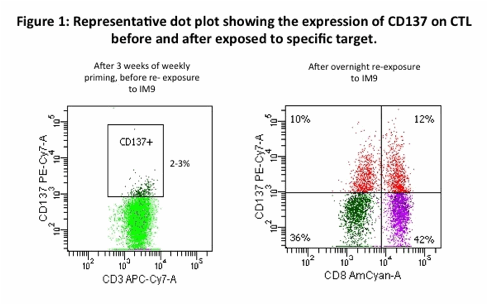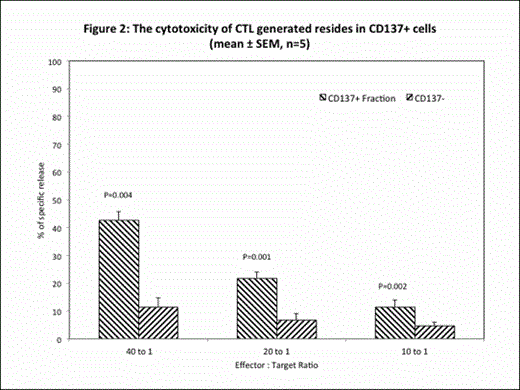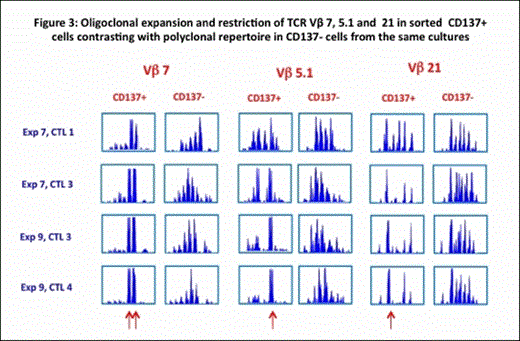Abstract
We have previously reported that cord blood T cells (CBT) can be expanded ∼ 2 log after 2 weeks in culture following stimulation with CD3/CD28 co-stimulatory beads and exogenous IL2 + IL7. The expanded progeny retained the starting naive phenotype typical of unmanipulated cord blood T cells (Cancer Research, Post-expansion, CD137, CD40L and perforin expression remains minimal and these cells demonstrate no cytotoxicity against an immunogenic lymphoblastoid cell line (IM9) or against transplant recipient PHA blasts. However, when primed against (IM9) or IFN-γ treated myeloid leukemia cell lines in the presence of IL12, IL7 and IL15, after 3 weeks of restimulation, lineage restricted cytotoxic activity was demonstrable (Cancer Research, ). Recently, we have demonstrated that IL15 alone can support the priming and expansion of CTL (abs 414, ASBMT 2013, manuscript in preparation) from CD3/CD28 expanded antigen inexperienced CB T cells.
CD137 (4-1BB) is a member of the TNFR- family and is expressed on activated T cells. 4-1BB ligation and signaling augments the survival, proliferation and lytic function of activated effectors. Expression of CD137 on activated T cells reflects recent activation. Therefore it may identify antigen-specific CTL. Adoptive T cell therapy with a restricted TCRVβ repertoire compared to bulk, unselected CTL pools is preferable to exclude potentially GVHD-causing clones in the HLA-mismatched cord blood transplant setting. Here we tested the hypothesis that de novo CD137 expression may identify leukemia-specific CTL precursors and that CD137 selection step could enrich for CTL clones in the priming culture.
IM9-specific CTL was generated from pre-expanded, >98% pure T cells using weekly stimulations with irradiated targets and IL15. After 3 weeks, cytotoxicity was tested against fresh IM9 leukemia cells in a Europium labeling assay. CD137 expressing cells were sorted on FACS Aria II (BD Biosciences). CD137- and CD137+ cells were re-tested for cytotoxicity and TCRβ CDR3 spectratyping was done to identify their clonality. RT2 profilerTM PCR array human Th1 & Th2 responses (SABiosciences) was employed to contrast the sorted populations for differential gene expression
After 3 weeks of priming/expansion, 2-3 % of the CTL were CD137+. However, after overnight re-stimulation, CD137 expression increased to a range of 12-39% of all T cells (Figure-1). The cytotoxicity of bulk cells in the culture segregated into the CD137+ cells after FACS sort (Figure-2). Amongst the 23 TCR Vβ families tested, distinct oligoclonal expansion of Vβ7, Vβ5.1 and Vβ21 were observed in the CD137+ population in contrast with CD137- T cells from the same culture, where the 3 Vβ families retained Gaussian-like, multiple clonal distributions (Figure-3). Notably, despite the different genetic background of starting CBT, the IM9 specific CTL activity appears to reside in the same CTL clones based on the virtually identical TCR Vβ clonality. This finding suggests that CTL targets have the greater influence on shaping CTL repertoir and not the genetic background (HLA, etc) of CBT cells. While post-sort RT qPCR analysis demonstrate significantly increased message for CCR4, EBI3, TNFRSF9 and TNFSF4 genes, CD40LG, IL2, IL6, IL7R, SFTPD and SPP1 expressions were significantly decreased in CD137+ cells.
IL15 without other exogenous cytokines supports the in vitro priming and expansion of polyclonal CTL against leukemia cell lines from expanded cord blood T cells. Cytotoxicity dominates in the CD137 positive subset, therefore CD137 positive selection can be used to isolate and enrich leukemia specific CTLs that retain a predictable TCRVβ repertoire shaped by the leukemic target. These findings will have great influence on attaining clinically applicable leukemia-specific CTL protocols.



No relevant conflicts of interest to declare.
Author notes
Asterisk with author names denotes non-ASH members.

This feature is available to Subscribers Only
Sign In or Create an Account Close Modal